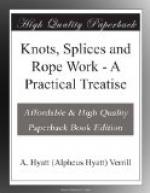The most difficult of ending knots and one which you should certainly learn is the “Matthew Walker” (Fig. 131), also known as the “Stopper Knot.” To form this splendid knot, pass one strand around the standing part of the rope and through its own bight, then pass B underneath and through bight of A and through its own bight also; next pass C underneath and around and through the bights of A, B, and its own bight. The knot will now appear as in Fig. 132, but by carefully hauling the ends around and working the bight taut a little at a time the knot will assume the appearance shown in Fig. 133. This is a handsome and useful knot and is widely used on ends of ropes where they pass through holes, as for bucket handles, ropes for trap-door handles, chest handles, etc. The knot is well adapted for such purposes, as it is hard, close, and presents an almost flat shoulder on its lower side.
[Illustration: FIG. 131.—Matthew Walker (making).]
[Illustration: FIG. 132.—Matthew Walker (complete but slack).]
[Illustration: FIG. 133.—Matthew Walker (complete).]
The “Turk’s Head,” Figs. 135 and 136, is a knot much used aboard yachts and warships and is so handsome and ornamental that it is a great favorite. It is used in ornamenting rigging, in forming shoulders or rings on stays or ropes to hold other gear in place, to ornament yoke lines, and for forming slip-collars on knife lanyards. It is also used to form collars around stanchions or spars, and, placed around a rope close beneath a man-rope knot, it gives a beautiful finish. When made of small line sailors often use the Turk’s Head as a neckerchief fastener. Although so elaborate in effect, it is really an easy knot to make, and while you may have difficulty in getting it right at first a little patience and practice will enable you to become proficient and capable of tying it rapidly and easily in any place or position. To make a Turk’s Head, have a smooth, round stick, or other object, and some closely twisted or braided small line. Pass two turns of the line around the rod, A, Fig. 135, from left to right, and pass the upper bight down through the lower and reeve the upper end down through it, as at B. Then pass the bight up again and run the end over the lower bight and up between it and the upper bight. Turn the upper bight again through the lower one and pass the end over what is now the upper bight and between it and the lower, C, Fig. 135. Now work from left to right, following the lay of the knot (or, in other words, passing your long end alongside the first end), D, Fig. 135, until a braid of two or more lays is completed, as shown in Fig. 136. The Turk’s Head may be drawn as tight as desired around the rope, or rod, by working up the slack and drawing all bights taut. A variation of the knot may be formed by making the first part as described and then by slipping the knot to the end of the rod; work one side tighter than the other until the “Head” forms a complete cap, as shown in Fig. 137. This makes a splendid finish for the ends of flagpoles, stanchions, etc.




